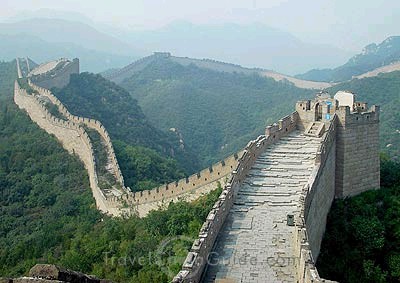
The Great Wall of China is a 4,000 mi. (6,400 km.) long series of stone and earth walls built and maintained since the 221 B. C. Although there had been walls to protect the Chinese states during the Warring States Period, it was not until Qin Shi Huang that the walls became a long, continuous wall. It was built as a protection against invading Huns and Mongols who were a major threat (especially the Mongols). A common misconception involving the Great Wall is that it can be seen from the moon, but it can only be seen from low Earth orbit.
The wall was originally started during the Warring States Period, when seven powerful states, the Qi, Chu, Yan, Hao, Zhao, Wei, and Qin, fought among each other. They built walls for protection against invaders and each other. In 221 B. C., Qin Shi Huang defeated the other six states, uniting China. He had the walls connected as protection against invaders and added his own. Thus Qin's wall, which stretched from modern Liaoning Province to Lintao in the Gansu Province, was built. During the Western Han Dynasty, the Huns became more powerful. The Han built more walls on a larger scale. The wall along the Hexi corridor, Yumenguan Pass, Yangguan Pass, Yanmenguan Pass, and Nianziguan Pass date to this time.
The Northern Wei, Northern Qi, and Northern Zhou Dynasties also built walls, but on a smaller scale. The Tang Dynasty had little need for walls, so none were constructed. The Ming saw the peak of wall building. Many minor tribes attacked China and so walls were always built in the north. The main walls stretched from Jiuliancheng near the Yalu River to the Jiayuguan Pass, some 4,600 mi. Many walls were extended and thickened. Although the early Qing Dynasty built some walls, they had little need and so the walls stopped being built and repaired.
The wall was not just a wall. There were passes, watchtowers, garrisons, beacon towers, and blockhouses. They were completely under the command of the military. The Great Wall was such an important part of China's defense that under the Ming Dynasty, there was a million soldiers guarding the wall. They eventually failed however, due to a traitorous general who opened the gates of Shanhaiguan Pass to allow the Mongols in. The Great Wall today, although it has lost its defensive value, is a symbol of the Chinese people.